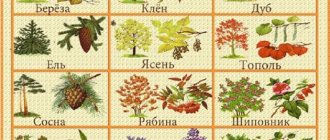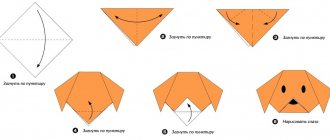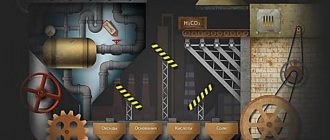Didactic game "Dishes"
Didactic game “Number. Sign. Subject" on the lexical topic "Utensils"
The game is intended for children aged 4-6 years with severe speech impairments, as well as for children of preschool and primary school age to develop the lexical and grammatical structure of speech.
Didactic game “Number. Sign. Subject" can be used both in individual and subgroup lessons with children.
Target:
This set of games will help an adult teach a child:
- agree nouns with numerals and adjectives in gender, number, case;
- select qualitative, relative, possessive adjectives for nouns;
- use ordinal numbers in speech, coordinate them with nouns and adjectives in gender, number, case;
- activate mental activity, associative thinking;
- make comparative sentences with the conjunction “a”.
Material for the game:
cards with game tasks in two subjects of the same lexical group; playing field and cut cards for independent selection and compilation of a plot series; sets of numbers.
Game description:
Game with ready-made models : each table contains tasks for two subjects of the same lexical group for a larger educational load. At the beginning of the game, the child needs to be clearly shown how associations can be used to indicate the characteristics of objects. For example, how can you depict a bitter taste, show the hardness, softness, juiciness of vegetables, color and shape.
Below are ready-made game cards:
- one porcelain deep plate;
- three shiny metal pans;
- two tall shiny glasses;
- five wooden large spoons;
- four sharp metal knives;
- six red plastic bowls;
- one yellow birch bark bread box;
- seven porcelain birch bark cups.
The game requires compliance with the following steps:
- Name a word denoting a number (what number? - four).
- Name the word denoting the object (what is it? - knife).
- Agree the noun with the numeral in gender (how many knives? - four knives).
- Name the words denoting the attribute of an object, coordinate them with numerals and nouns in gender, number (four knives (which ones?) - metal, sharp).
- Agree the numeral with the adjectives and nouns in gender and number. (Say in a complete sentence, starting with the number. – Four sharp metal knives.)
- Using the same principle, consider another object of the lexical group - a bowl.
- Make comparative sentences with the conjunction “a”. (There are four knives, and six bowls. The knife is metal, and the bowl is plastic, etc.)
Game with cut cards : played on the same principle as with ready-made models. Only here the child takes an active position and is given more independence.
First, you should invite the child to choose an item on a lexical topic and place it in a sector with an asterisk, then a number (place in the first sector) and select adjectives in the form of picture symbols (place in the longest sector of the playing field). The symbol pictures are first reviewed and what they mean is explained.
To better understand the progress of the game with cut cards, a sample is provided below.
Using the didactic game “Number. Sign. Subject" children will quickly master the skills of agreeing adjectives, nouns and numerals in gender, number, case; will learn to select adjectives for nouns and develop their associative thinking.
The development of associative thinking has a positive effect on the process of memorizing and reproducing necessary information.
On our website you can find other educational games from the “Number” series. Sign. Item". To do this, follow the highlighted link .
We wish everyone success.
Riddles about dishes
• It is round, but not a ball, Copper is not a coin, Scarlet heat burns in it, It warms the water. He is an expert at making tea, he remembered the teapot for nothing! After all, people have called him for centuries... (Samovar!)
• Among spoons, I am a colonel. And my name is... Ladle! • Soup, salad, mashed potatoes, cutlets Always served in ... (Plate) • And for tea and curdled milk Place, my friend, ... (Cup) • On the stove - the boss of the pots. Fat, long-nosed... (Teapot) • A boat is floating on my plate. I put the boat of food into my mouth. (Spoon) • The teapot's girlfriend Has two ears, Cooks porridge and soup for Yulia. And its name is... (Pan) • There will be delicious food With a golden crust, If you use... That's right, a frying pan! • We don’t eat ourselves, but we feed people (with spoons) • She’s friends with the ladle. She’ll cook porridge for us for dinner. Mom Julia loves her. What's her name? (Castle)
• I eat table soup for lunch, I try dessert with tea, Give me a little more, Where is my big... /spoon/? • It has 4 horns on one wide leg, But it’s not a saw at all, For cutlets and meat... /fork/ • Be careful, look, You take it in your hand, You won’t always understand how it will cut your hand... /knife/
• The nose is puffing and breathing steam, The hot side is bursting with steam, And inside the drink is a herbalist, It is my mother’s favorite... /teapot/ • It’s hot on the stove, Hides the deliciousness under the lid, Mommy cooks porridge in it, Two handles, one... /saucepan/ • It’s like a pancake is round, I ate the porridge all to the bottom, I see Sevka’s smile, He lives on the bottom... /plate/ • Steep-sided and tall, Oh, now I’ll get drunk with juice, Delicious things are not a lie, My... /glass/ • Everyone really likes her, She's a beauty on a silver platter, She's a cutie with one hand, Little blue... /cup/ • And pancakes, and an omelet, And potatoes for lunch, And pancakes - wow! Fries everything... /frying pan/
• The fat man stands, his barrel akimbo, hissing and boiling, telling everyone to drink tea. Samovar • The dishes made from me are thin, soft white and sonorous. They have been fired since ancient times. I call myself... Porcelain • I puff, puff, I don’t want to get warm anymore. The lid rang loudly: “Drink tea, the water has boiled!” Teapot • Carries water to the Owner to please; Lives with him until he falls. The cup • Inaccessible in appearance, stands with its arms akimbo, But inside, look, there’s a treat inside! Sugar bowl • I store hot, I store cold, I will replace both the stove and the refrigerator for you on a hike. Thermos • If I'm empty, I don't forget about myself, But when I'm carrying food, I won't pass by my mouth. Spoon • New dishes, but all full of holes. Sieve • There is a button on the head, There is a sieve in the nose, One hand, And even that on the back. The kettle • Boils - steam comes out, And whistles, and bursts with heat, The lid rattles, knocks. -Hey, take me off! - shouts. Teapot • Purebred, portly Boyar Allows water to all the people. Samovar • I grumble and grumble on the fire Then I sneeze and let off steam. Kettle • It can be deep. It can be small. However, this is not a river. Plate • I was born in the earth, tempered in fire. Pot • A fire burns amidst the water, The water does not drown it. Samovar • Made for liquid, but liquid does not hold in it. Funnel • The teapot's girlfriend Has two ears, Cooks porridge and soup for Yulia. And her name is... Saucepan • I feed everyone with pleasure, And I myself am mouthless. Spoon • On the stove - the boss of the pots. Thick, long-nosed... Teapot • As soon as he starts talking and talking, you need to brew tea as soon as possible. Teapot • He has a big belly, and is not a hippopotamus at all. He raised his trunk and nose, But, however, he was not an elephant. And he puffs through his nose on the stove like a steam locomotive. Kettle
• Although he turned his nose up, But this is not serious at all. He is not proud of anyone, Anyone who wants to drink will be convinced. Teapot • A boat is floating on my plate. I send the boat with food into my mouth. Spoon • What tool can you use to slurp cabbage soup? Spoon • Long-tailed horse Brought us sweet porridge. The horse is waiting at the gate - Open your mouth wider. Spoon • Who is she? He will scoop up the porridge and put it in his mouth. Spoon • If sharpened well, it cuts everything very easily - Bread, potatoes, beets, meat, Fish, apples and butter. Knife • The whole top is in small holes – Bitterness is bitter in the plates. Pepper shaker • Among spoons, I am a colonel. And my name is... Ladle • The new vessel is full of holes. Sieve • We bought a brand new one, it’s so round, we shake it in our hands, but it’s all full of holes. Sieve • Tell me what to call her: Her teeth are all full of holes, But she grinds beets, radishes, horseradish, carrots deftly. Grater • Hard, full of holes, prickly, clumsy. Whatever they put on her back, she will immediately devour everything. Grater • Sivka is lying - The back is chipped. Grater • The big-nosed Foka has his hands on his hips all the time. Foka boils water and shines like a mirror. Samovar
History of dishes for children
It is difficult to imagine the life of a modern person without dishes. The history of the appearance of dishes is closely connected with the history of the development of humanity as a whole. The shape, size and quality of dishes have always reflected a certain stage of human development. The appearance of dishes occurred around the 7th millennium BC.
Primitive people learned to weave baskets from twigs, and to coat these baskets with clay for strength. The baskets were left to dry in the sun - this allowed them to become durable. The result was the first container in which dry foods, such as cereals, could be stored. It was impossible to pour water there - the clay would immediately become soggy. The clay basket accidentally fell into the fire, and people saw that after firing it became very strong. Now it was possible to store liquids in it and even cook something over a fire. This is how primitive people learned to sculpt and fire clay pots. In ancient Greece and Rome, ceramic dishes reached their peak - images of gods and heroes were skillfully applied to any object. Clay dishes are still popular today, because this material is one of the safest for human health.
Pieces of copper ore sometimes fell into the fire along with the wood. And people have noticed how copper changes shape at high temperatures, so it can now be sharpened or bent. This is how the first metal utensils appeared.
For a long time, dishes in Rus' were only made of wood and clay. Instead of modern saucepans, ceramic pots of different sizes and shapes were used. Much later, cast iron pots made from cast iron appeared. Even later, dishes made of glass, silver and porcelain appeared. Over time, Russian craftsmen learned to create beautiful dishes with unique paintings.
Even before the advent of plates, food was placed directly on the table and eaten with hands. A large piece of bread served as an individual “plate” for each person; food was placed in its recess. It is interesting that the first plates appeared among the French kings and only for the most ceremonial receptions. Moreover, they were all only square in shape.
If we talk about cutlery, then the knife appeared first and only then spoons and forks. Of course, at first the knife was not a cutlery; it was used by men for hunting. It was a heavy stone product, and only later did the knives become more convenient - metal. Knives for the kitchen and for other needs were no different, and therefore they were dangerous. In the 18th century, Napoleon ordered the tip of a table knife to be blunted and rounded for safety.
The first spoons were mostly made of wood, sometimes they were carved from bone or even stone. In Greece, suitable shells were used instead of spoons. In Rus' it was customary to carry your own spoon with you. It was placed in the bosom, in a special box, tucked into a belt or behind the top of a boot. Dahl's dictionary lists many types of spoons for different purposes.
The very first fork had only two teeth and was absolutely flat, without bends, it could not be used to scoop up food. It was much larger than a modern device, because its direct purpose was to pull large pieces of meat from a cauldron or brazier. The appearance of the fork dates back to the 9th century. Maria Mniszech brought the fork to Russia, which caused great surprise at court.
Another important type of cookware is the frying pan; at first it was an ordinary flat stone. And food was practically not fried on it, it was simply dried. Frying pans made of metal and ceramics appeared a little later. With their appearance, housewives were able to expand the menu, because now food could be truly fried.
Nowadays, many dishes are made of plastic. These are mainly plastic containers for storing food, children's dishes or disposable items for picnics. A short journey into history allows you to appreciate how rich and varied the arsenal of tableware is in our time.
Progress of the lesson to study the topic “Utensils”
1. Lesson “Magic bag”
“I have this beautiful bag, and there’s something in it.” Let's see what's inside? Children take turns taking objects out of the bag. Children (3-4 years old) - one object at a time, name it and put it on the table. The older ones try to guess the object by touch, take it out and put it on the table.
2. Conversation
— How can you call all these objects in one word? - Why do we need it? For children (3-4 years old) they name a specific item and ask what we need it for.
3. Lesson “Feed Masha”
— The doll Masha came to visit us. And as is customary, guests must be treated to something. — Let's prepare lunch for our guest. What do we need for this? (Pot, ladle, frying pan) The utensils that we need for cooking are called kitchen utensils. - Let's feed Masha our lunch. What will we take for this? (Deep plate, shallow plate, fork, spoon) The dishes from which we eat are called tableware, and what we use is called cutlery. - Well, after lunch you can give Masha some delicious tea. Take the dishes that we need for this (teapot, saucer, cup, teaspoon). It's called a tea room.
4. Physical school
5. Lesson “What is it stored in?”
Illustrations are posted on the board. Children (5-7 years old) say the answer themselves. An adult helps the younger ones. — Sugar (in a sugar bowl) — Salt — Pepper — Butter — Bread — Sweets — Sauce — Tureen
6. Lesson “What dishes are made of”
An adult places plates (salad bowls) on the table. - How are all these objects similar? (form, purpose) - How are they different? (color, material of manufacture) - Dishes are made from different materials.
Tell me the name of the dishes made from: Glass Wood Porcelain Plastic Metal (Older children name it themselves, younger children with the help of an adult) - If you drop a glass plate, what will happen to it? — If you drop a spoon on the floor, what happens to it?
7. Activity “Collect the fragments”
Children are given pictures of objects cut into several parts. We need to collect pictures. “I wasn’t careful today and broke several objects.” Collect the pictures and find out what was broken.
8. K. Chukovsky “Fedorino’s grief”
- Let’s remember the fairy tale “Fedorino’s grief.” - What happened to Fedora? - Why did the dishes run away from her? — How should you care for plates, forks, and spoons?
9. Summary of the lesson
— Today we talked about dishes, that they are very important and necessary in our lives. We found out that it can be a tea room, a kitchen room, or a dining room. It is made from various materials, so it can be glass, porcelain, wood, or metal. Some materials make it strong, while others make it fragile and can be broken. The dishes must be handled very carefully, washed and put back in their places.




![Hard and soft sound [d]](https://ls-kstovo.ru/wp-content/uploads/tverdyj-i-myagkij-zvuk-d3-330x140.jpg)

